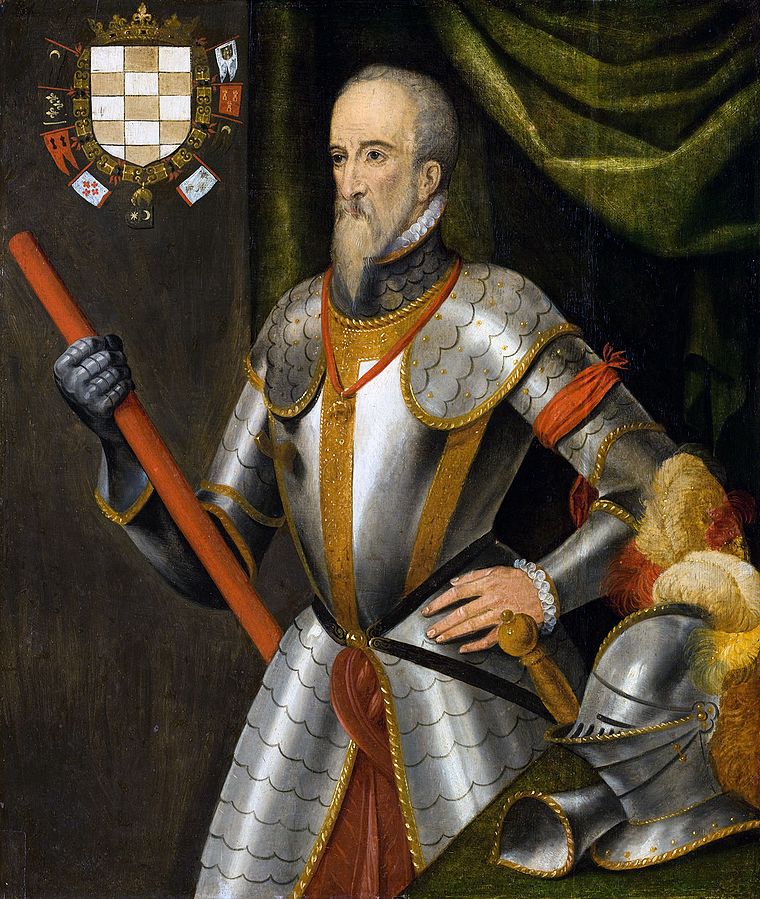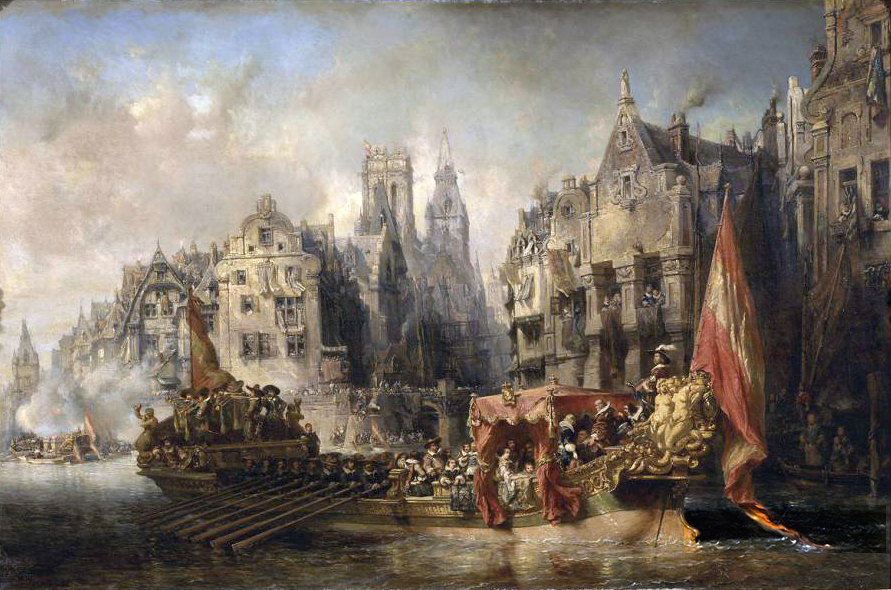(FERNANDO ALVAREZ DE TOLEDO)
Born 1508, of one of the most distinguished Castilian families, which boasted descent from the Byzantine emperors; died at Thomar, 12 January, 1582. From his earliest childhood the boy was trained by a severe discipline for his future career as warrior and statesman. In his sixteenth year he took part in the war against France; a year later he was in the siege of Pavia, and in 1527 fought against the Turks in Hungary. He enjoyed the esteem of the Emperor Charles V, and played a great role in the numerous wars in which Spain was involved for half a century. His chief fame rests upon his mission in 1557 to the riotous Netherlands, where the Gueux had created systematic opposition to the Spanish regent, Margaret of Parma. In the Netherlands, traditionally accustomed to free government, King Philip, though born a Dutchman, essayed to establish an absolutism such as prevailed in Spain. He rejected the mild measures proposed by moderate counsellors, and held that a swift punishment should meted out to this rebellious and heretical country. At first Philip resolved to go himself to the Netherlands, but towards the end of November, 1567, he suddenly informed Margaret of Parma that he would send the Duke of Alva to punish the guilty with unbending severity. The “iron duke” was to be the ideal instrument for the execution of this purpose.
The very announcement of Alva’s coming spread terror and consternation. Prince William of Orange and other leaders of the Gueux fled to foreign countries. But the popular Counts of Egmond and Hoorne, through blind confidence or reckless courage, resolved to face Alva. On 22 August, Alva, accompanied by a body of select Spanish troops, made his entry into Brussels. He immediately appointed a council to condemn without trial those suspected of heresy and rebellion. On 1 June, 1568, Brussels witnessed the simultaneous decapitation of twenty-two noblemen; on 6 June followed the execution of the Counts of Egmond and Hoorne. The “Council of Blood” was the popular designation of Alva’s tribunal. The Flemings fled in thousands to Holland and Zeeland, where the elements of the rebellion were concentrated under the leadership of the Prince of Orange. In the meantime Alva began a regular campaign in the northern provinces. His victorious troops, whose banner was inscribed with the legend: “Pro lege, rege, grege,” and plundered the cities of Mons, Mechlen, Zutphen, and Naarden, and left them drenched in blood. In triumph, Alva returned to Brussels. Pope Pius V bestowed on him a consecrated hat and sword, a present heretofore only given to sovereigns. In Antwerp, the governor erected a bronze statue in his own honour; it represented Alva trampling under his feet two allegorical figures, the nobility and the people. The dictator had proclaimed that the expenses of the war must be borne by the Netherlands. In consequence, the resources of the people were drained by taxation. Notwithstanding the protestations of the States-General he introduced the so-called “tax of the one hundredth, twentieth, and tenth penny.” This exaction surpassed all bounds. When on 31 July in Brussels the twentieth and tenth penny were extorted, traffic and commerce came to a standstill. The Dutch people, still for the greater part Catholic, felt themselves outraged in their rights by the “Council of Blood,” and their inborn love of freedom by the Spanish Inquisition. When they saw their commerce and industries trammelled by the odious tenth penny tax, the hatred against the Spanish régime grew so manifest and widespread, that Alva, although victorious on the field of battle, suffered an irremediable moral defeat. The surprising conquest of the little seaport of Brielle by the “Beggars of the Sea” was the inspiration that fanned anew the smouldering embers of the rebellion. Haarlem, after a long siege capitulated to Don Frederic, son of Alva, 12 July, 1573; but this victory was speedily followed by the defeat of Alkmaar, which defended itself so heroically that the popular cry became: “From Alkmaar, victory begins!”
Alva at last realized that his violent measures were fruitless. “God and mankind are against me,” he exclaimed in despair. In vain he begged the King to let him retire. His soft-hearted successor, the Duke of Medina Celi, who passed through the country in June, 1572, never really assumed the reins of government but shortly returned to Spain. The 19 October, 1573, Alva was definitively relieved of his office and succeeded by Don Luis of Requesens. He hastened from the Netherlands, followed by the curse of its people. The Catholic councillor Viglius testified: “Tristis venit, tristior abiit.” Once again in Spain he still retained the royal favour, till a love affair of Don Frederic dragged father and son into disgrace. Alva remained in exile at his castle up to 1580, when the acknowledged power of his iron hand was sought in the war against Portugal. In the short space of three weeks he completely subdued the Portuguese. Dissension broke out once more between Philip and Alva, but the Duke had made himself so powerful that Philip, though suspecting that Alva had enriched himself extraordinarily with the spoils of war, and knowing that he refused to account to his King, did not dare raise a hand against the first grandee of Spain. A short time after he died at Thomar, 12 January, 1582. Alva was, as even Motley in “The Rise of the Dutch Republic” (London, 1868, 9, 336), admits, “the most successful and experienced general of Spain, or of Europe, in his day. No man had studied military science more deeply, or practiced it more constantly.” In sixty years of military service he was never surprised, never defeated. He excelled in slow and prudent tactics, deeming that nothing was so uncertain as victory. He stands amongst the greatest generals of history. Yet his greatness was confined to the battlefield. He lacked the wisdom of governing.
 His tyranny, however blameable, was exaggerated by the hatred of opposing parties. Alva boasted, it is said, that he put to death on the scaffold 18,000 Dutchmen; but his successor, Requesens, estimated his executions at 6,000 (Gachard, Etudes, II, 366). Motley paints him in the blackest colours, allowing in his favour only the excuse “that he was but the blind and fanatically loyal slave of his sovereign” (541). In reality, Alva came to the Netherlands to carry out the royal orders, and save the King’s popularity by taking upon himself the odium of the rigorous suppression of the rebellion. He erected his own statue in Antwerp, not to glorify himself, but to pose as the tyrannous suppressor of the rebellion. In order that Philip might play the role of a bold sovereign, he asked the King to order the demolition of the statue (E. Gossart, Bulletin de l’académie de Belgique, 1899, 234-244). While we deplore his tyrannous method we must give credit to the duke’s loyalty. When his personal dignity and views were touched, he dared defy even his King. He was an ardent Catholic, who fiercely served his religion when he combated heresy with fire and sword, but who, as a child of such troublous times, unwisely chose his measures. Notwithstanding his fanaticism he boldly entered the campaign against Paul IV, and when the King offered an advantageous peace to the Pope, the Duke exclaimed angrily that submission and timidity did not agree with politics and war. Alva, like his King, has been blackened savagely by prejudiced historians. As Maurenbrecher says, the caricatures of both have their origin in the passionate apology for William of Orange. As to Motley’s historical work quoted above, Guizot remarks that “M. Motley exhibits in his work both science and passion” (Melanges biograph. et litteraires, Paris, 1808). His judgment of Alva is neither objectively justified nor of definitive value.
His tyranny, however blameable, was exaggerated by the hatred of opposing parties. Alva boasted, it is said, that he put to death on the scaffold 18,000 Dutchmen; but his successor, Requesens, estimated his executions at 6,000 (Gachard, Etudes, II, 366). Motley paints him in the blackest colours, allowing in his favour only the excuse “that he was but the blind and fanatically loyal slave of his sovereign” (541). In reality, Alva came to the Netherlands to carry out the royal orders, and save the King’s popularity by taking upon himself the odium of the rigorous suppression of the rebellion. He erected his own statue in Antwerp, not to glorify himself, but to pose as the tyrannous suppressor of the rebellion. In order that Philip might play the role of a bold sovereign, he asked the King to order the demolition of the statue (E. Gossart, Bulletin de l’académie de Belgique, 1899, 234-244). While we deplore his tyrannous method we must give credit to the duke’s loyalty. When his personal dignity and views were touched, he dared defy even his King. He was an ardent Catholic, who fiercely served his religion when he combated heresy with fire and sword, but who, as a child of such troublous times, unwisely chose his measures. Notwithstanding his fanaticism he boldly entered the campaign against Paul IV, and when the King offered an advantageous peace to the Pope, the Duke exclaimed angrily that submission and timidity did not agree with politics and war. Alva, like his King, has been blackened savagely by prejudiced historians. As Maurenbrecher says, the caricatures of both have their origin in the passionate apology for William of Orange. As to Motley’s historical work quoted above, Guizot remarks that “M. Motley exhibits in his work both science and passion” (Melanges biograph. et litteraires, Paris, 1808). His judgment of Alva is neither objectively justified nor of definitive value.
MEURSIUR, Ferd. Albanus, seu de Rebus ejus in Belgio Gestis, libri IV (Leyden, 1614; Amsterdam, 1638); STRADA, De Bello Belgico (Rome, 1640), I-II; DE VERA Y FIFUERVA, Resultas de la vita de Ferd. Alvares de Toledo (1643), I-V; Vita Ferd. Toletani ducis Albani (Salamanca, 1669); Vie du duc d’Albe (Paris, 1698); DE RUSTANT, Historia de D. Ferd. Alvarez de Toledo, clamado el Grande, duque de Alva (Madrid, 1750), I-II; PRESCOTT, History of the Reign of Philip II (Boston, 1855), I-III; NUYENS, Geschiedenis der Nederlandsche broerten (Amsterdam, 1865), I-IV; BAUMSTARK, Philip II, Koenig von Spanien (Freiburg, 1875); VON RANKE, De Osmanen und die Spanische Monarchie im 16. und 17. Jahrh. (Collective ed., XXXV, XXXVI, Leipzig, 1877); FORNERON, Histoire de Philippe II (Paris, 1881), I-IV; DE LETTENHOVE, Les Huguenots et les Gueux (Bruges, 1883-85), I-VI; BLOK, Geschiedenis van het Nederlandsche volk (Groningen, 1896), tr. by RUTH PUTNAM, III; BLOK, History of the People of the Netherlands Part III, The War with Spain (New York and London, 1900).
GISBERT BROM (Catholic Encyclopedia)











